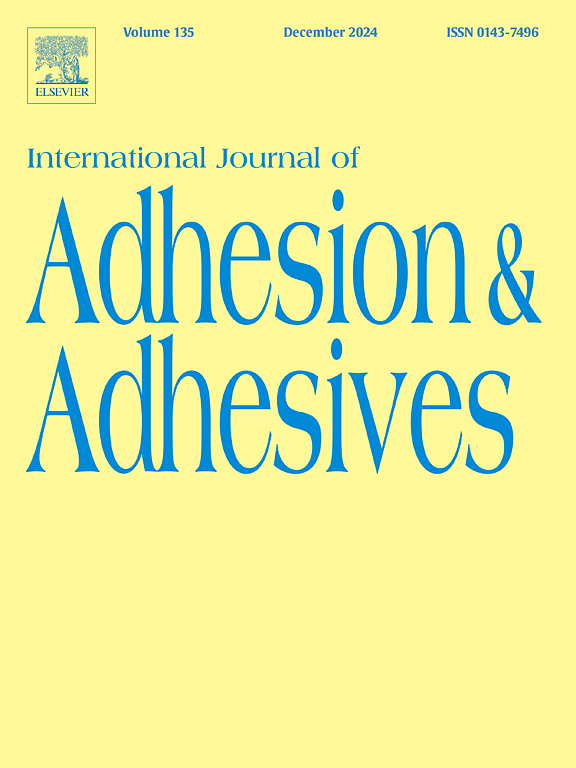Effect of laser patterned microscale interlocking features on aluminum adhesive-bonded single lap joints
IF 3.5
3区 材料科学
Q2 ENGINEERING, CHEMICAL
International Journal of Adhesion and Adhesives
Pub Date : 2025-05-05
DOI:10.1016/j.ijadhadh.2025.104047
引用次数: 0
Abstract
Many attempts have been made to enhance the strength or toughness of adhesive-bonded joints by fabricating macroscopic interlocking features on adherends or resorting to 3D-printing to produce microscale surface structures. Laser ablation has recently been proposed as a method to manufacture serrated surface profiles on aluminum single lap joints with the aim of improving strength; however, increases have so far been limited due to joint failure resulting from peeling phenomena at the end of the overlap, making enhancements in mechanical interlocking ineffective in the loading direction. The present work seeks to overcome these limitations, increasing the role of interlocking in strengthening laser patterned joints by employing deeper tooth-like features to increase geometric interlocking and thicker substrates to minimize the effect of bending-induced peeling on the initiation and development of failure. Several different patterns have been produced and tested, including both symmetrical (identical adherends) and asymmetrical (complementary adherends) with different feature orientations with respect to the loading direction. The results have revealed that, on single lap joints with thicker adherends, by using deeper asymmetrical features, the strength can be increased by 40 % compared to that obtained with flat adherends.
激光图案化微尺度联锁特性对铝胶粘剂单搭接接头的影响
通过在粘附物上制造宏观联锁特征或借助3d打印来生产微尺度表面结构,已经进行了许多尝试来提高粘合接头的强度或韧性。激光烧蚀是最近提出的一种以提高强度为目的在铝单搭接接头上制造锯齿形表面轮廓的方法;然而,到目前为止,由于重叠末端剥落现象导致的接头破坏,使得机械联锁的增强在加载方向上无效,因此增加有限。目前的工作旨在克服这些限制,通过采用更深的齿状特征来增加几何联锁和更厚的衬底来增加联锁在加强激光图案接头中的作用,以最大限度地减少弯曲引起的剥落对失效的开始和发展的影响。已经产生并测试了几种不同的图案,包括对称(相同粘附体)和不对称(互补粘附体),它们具有相对于加载方向不同的特征方向。结果表明,在具有较厚粘附层的单搭接节点上,通过使用更深的不对称特征,强度可以比扁平粘附层提高40%。
本文章由计算机程序翻译,如有差异,请以英文原文为准。
求助全文
约1分钟内获得全文
求助全文
来源期刊

International Journal of Adhesion and Adhesives
工程技术-材料科学:综合
CiteScore
6.90
自引率
8.80%
发文量
200
审稿时长
8.3 months
期刊介绍:
The International Journal of Adhesion and Adhesives draws together the many aspects of the science and technology of adhesive materials, from fundamental research and development work to industrial applications. Subject areas covered include: interfacial interactions, surface chemistry, methods of testing, accumulation of test data on physical and mechanical properties, environmental effects, new adhesive materials, sealants, design of bonded joints, and manufacturing technology.
 求助内容:
求助内容: 应助结果提醒方式:
应助结果提醒方式:


